Foundations of Professional Planning: Skills and Nursing Industry
VerifiedAdded on 2022/12/22
|8
|1686
|1
Essay
AI Summary
This essay provides an overview of the Australian nursing industry, highlighting the roles of NMBA, ANMAC, and APHRA in regulating the profession. It identifies key professional skills such as communication, decision-making, attention to detail, confidence, flexibility, and organizational skills, emphasizing the importance of ethical compliance with NSHQS standards. The essay also reflects on personal skills relevant to nursing, including strong communication and creativity, while acknowledging weaknesses such as hesitance in patient handovers. The author notes a preference for visual learning and the importance of understanding personal strengths and weaknesses in the context of providing high-quality patient care.
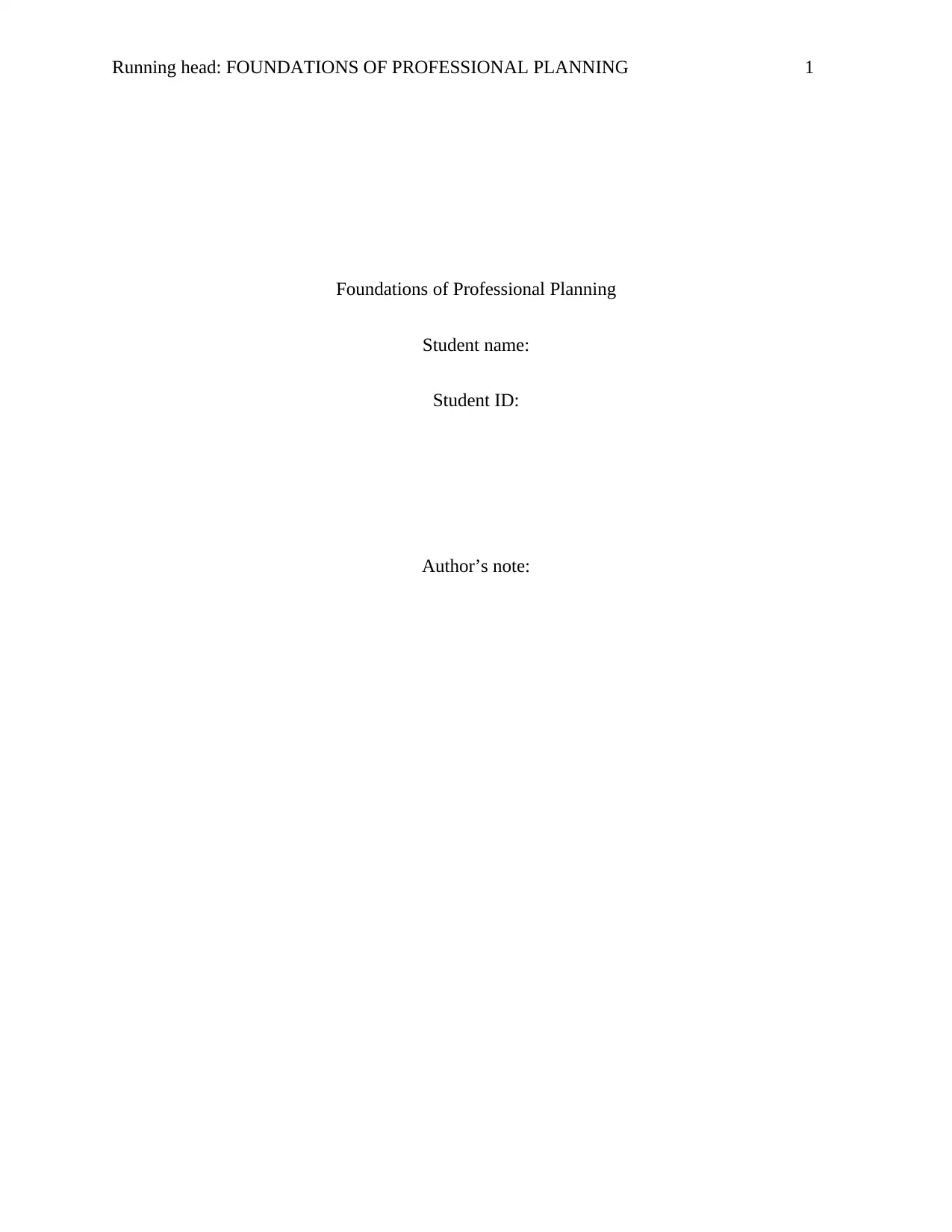
Running head: FOUNDATIONS OF PROFESSIONAL PLANNING 1
Foundations of Professional Planning
Student name:
Student ID:
Author’s note:
Foundations of Professional Planning
Student name:
Student ID:
Author’s note:
Paraphrase This Document
Need a fresh take? Get an instant paraphrase of this document with our AI Paraphraser
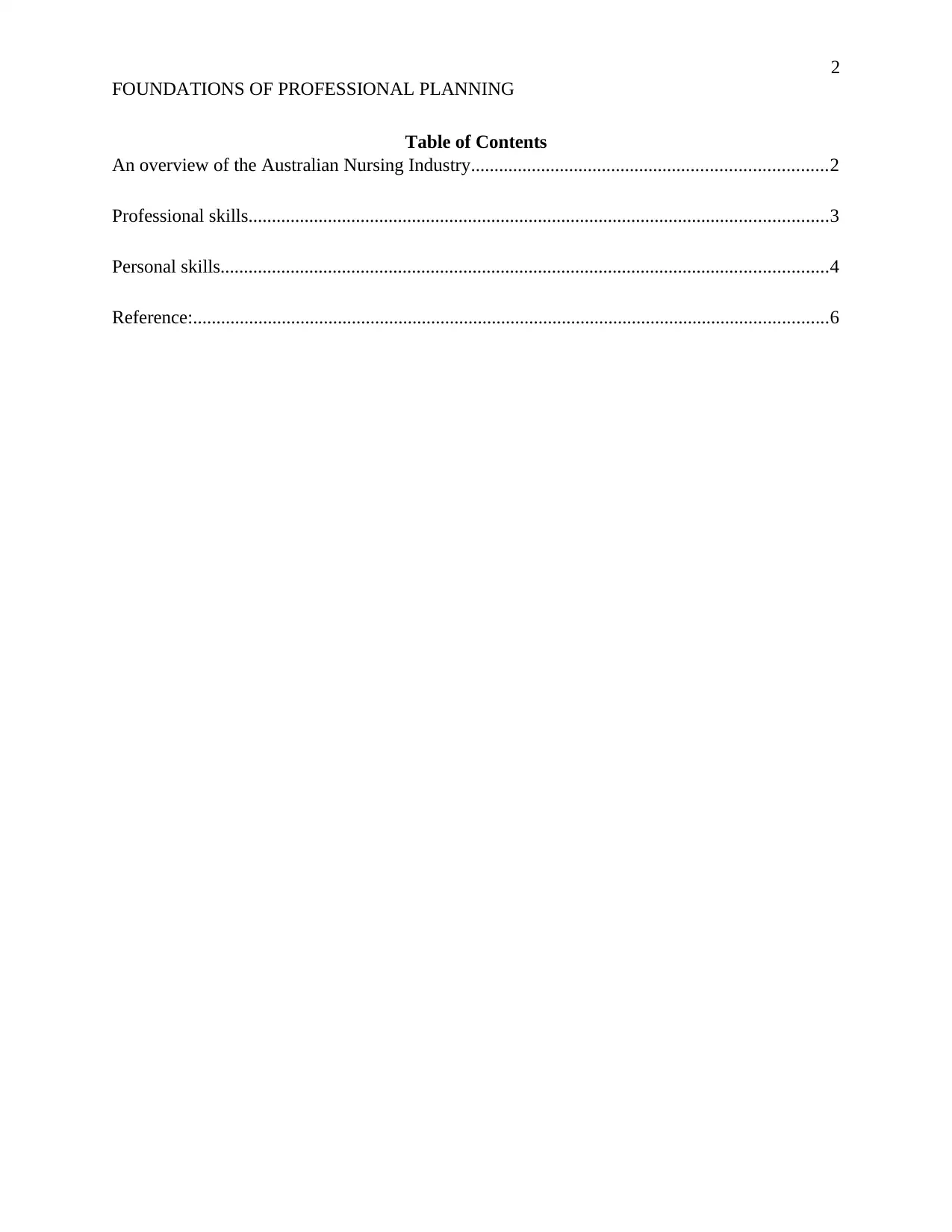
2
FOUNDATIONS OF PROFESSIONAL PLANNING
Table of Contents
An overview of the Australian Nursing Industry............................................................................2
Professional skills............................................................................................................................3
Personal skills..................................................................................................................................4
Reference:........................................................................................................................................6
FOUNDATIONS OF PROFESSIONAL PLANNING
Table of Contents
An overview of the Australian Nursing Industry............................................................................2
Professional skills............................................................................................................................3
Personal skills..................................................................................................................................4
Reference:........................................................................................................................................6
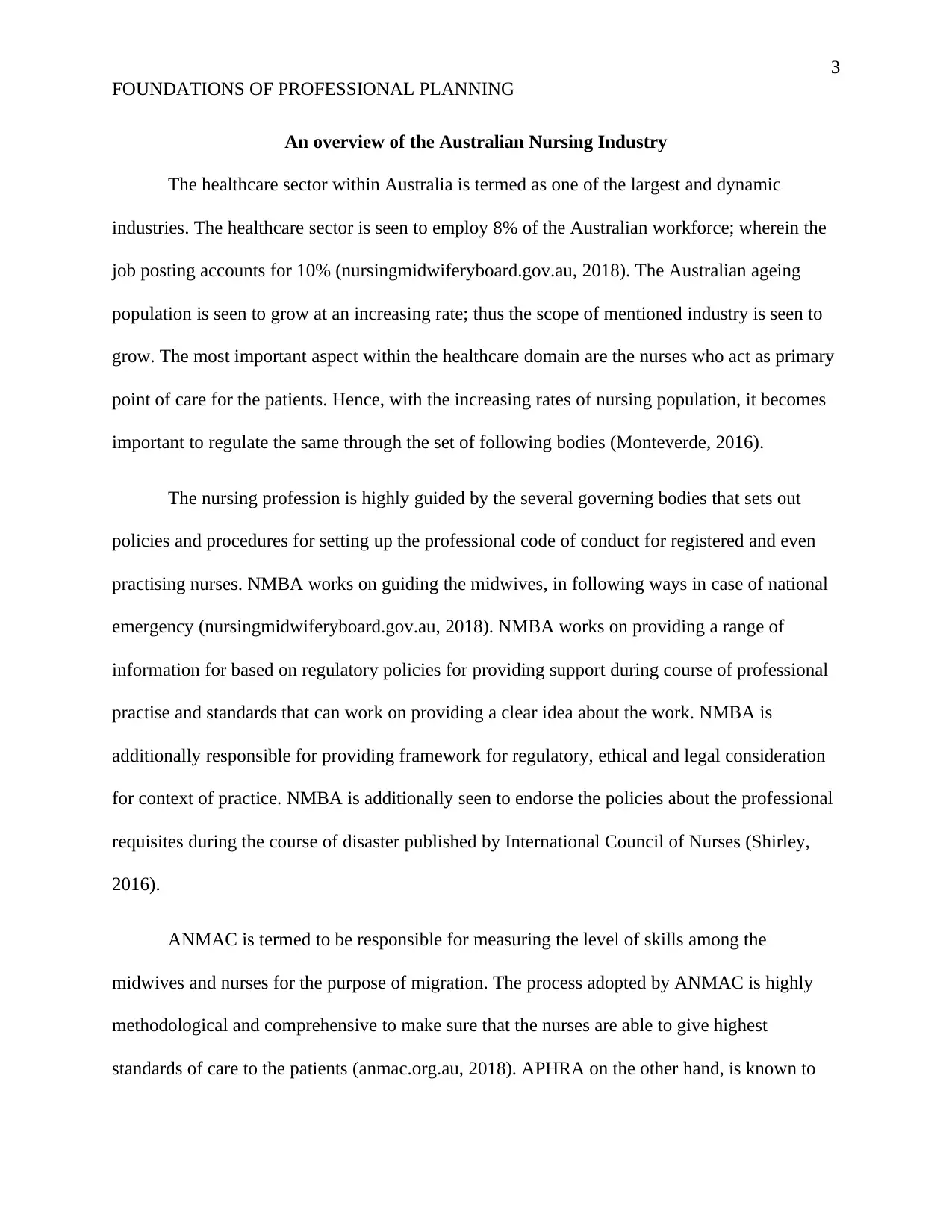
3
FOUNDATIONS OF PROFESSIONAL PLANNING
An overview of the Australian Nursing Industry
The healthcare sector within Australia is termed as one of the largest and dynamic
industries. The healthcare sector is seen to employ 8% of the Australian workforce; wherein the
job posting accounts for 10% (nursingmidwiferyboard.gov.au, 2018). The Australian ageing
population is seen to grow at an increasing rate; thus the scope of mentioned industry is seen to
grow. The most important aspect within the healthcare domain are the nurses who act as primary
point of care for the patients. Hence, with the increasing rates of nursing population, it becomes
important to regulate the same through the set of following bodies (Monteverde, 2016).
The nursing profession is highly guided by the several governing bodies that sets out
policies and procedures for setting up the professional code of conduct for registered and even
practising nurses. NMBA works on guiding the midwives, in following ways in case of national
emergency (nursingmidwiferyboard.gov.au, 2018). NMBA works on providing a range of
information for based on regulatory policies for providing support during course of professional
practise and standards that can work on providing a clear idea about the work. NMBA is
additionally responsible for providing framework for regulatory, ethical and legal consideration
for context of practice. NMBA is additionally seen to endorse the policies about the professional
requisites during the course of disaster published by International Council of Nurses (Shirley,
2016).
ANMAC is termed to be responsible for measuring the level of skills among the
midwives and nurses for the purpose of migration. The process adopted by ANMAC is highly
methodological and comprehensive to make sure that the nurses are able to give highest
standards of care to the patients (anmac.org.au, 2018). APHRA on the other hand, is known to
FOUNDATIONS OF PROFESSIONAL PLANNING
An overview of the Australian Nursing Industry
The healthcare sector within Australia is termed as one of the largest and dynamic
industries. The healthcare sector is seen to employ 8% of the Australian workforce; wherein the
job posting accounts for 10% (nursingmidwiferyboard.gov.au, 2018). The Australian ageing
population is seen to grow at an increasing rate; thus the scope of mentioned industry is seen to
grow. The most important aspect within the healthcare domain are the nurses who act as primary
point of care for the patients. Hence, with the increasing rates of nursing population, it becomes
important to regulate the same through the set of following bodies (Monteverde, 2016).
The nursing profession is highly guided by the several governing bodies that sets out
policies and procedures for setting up the professional code of conduct for registered and even
practising nurses. NMBA works on guiding the midwives, in following ways in case of national
emergency (nursingmidwiferyboard.gov.au, 2018). NMBA works on providing a range of
information for based on regulatory policies for providing support during course of professional
practise and standards that can work on providing a clear idea about the work. NMBA is
additionally responsible for providing framework for regulatory, ethical and legal consideration
for context of practice. NMBA is additionally seen to endorse the policies about the professional
requisites during the course of disaster published by International Council of Nurses (Shirley,
2016).
ANMAC is termed to be responsible for measuring the level of skills among the
midwives and nurses for the purpose of migration. The process adopted by ANMAC is highly
methodological and comprehensive to make sure that the nurses are able to give highest
standards of care to the patients (anmac.org.au, 2018). APHRA on the other hand, is known to
⊘ This is a preview!⊘
Do you want full access?
Subscribe today to unlock all pages.

Trusted by 1+ million students worldwide
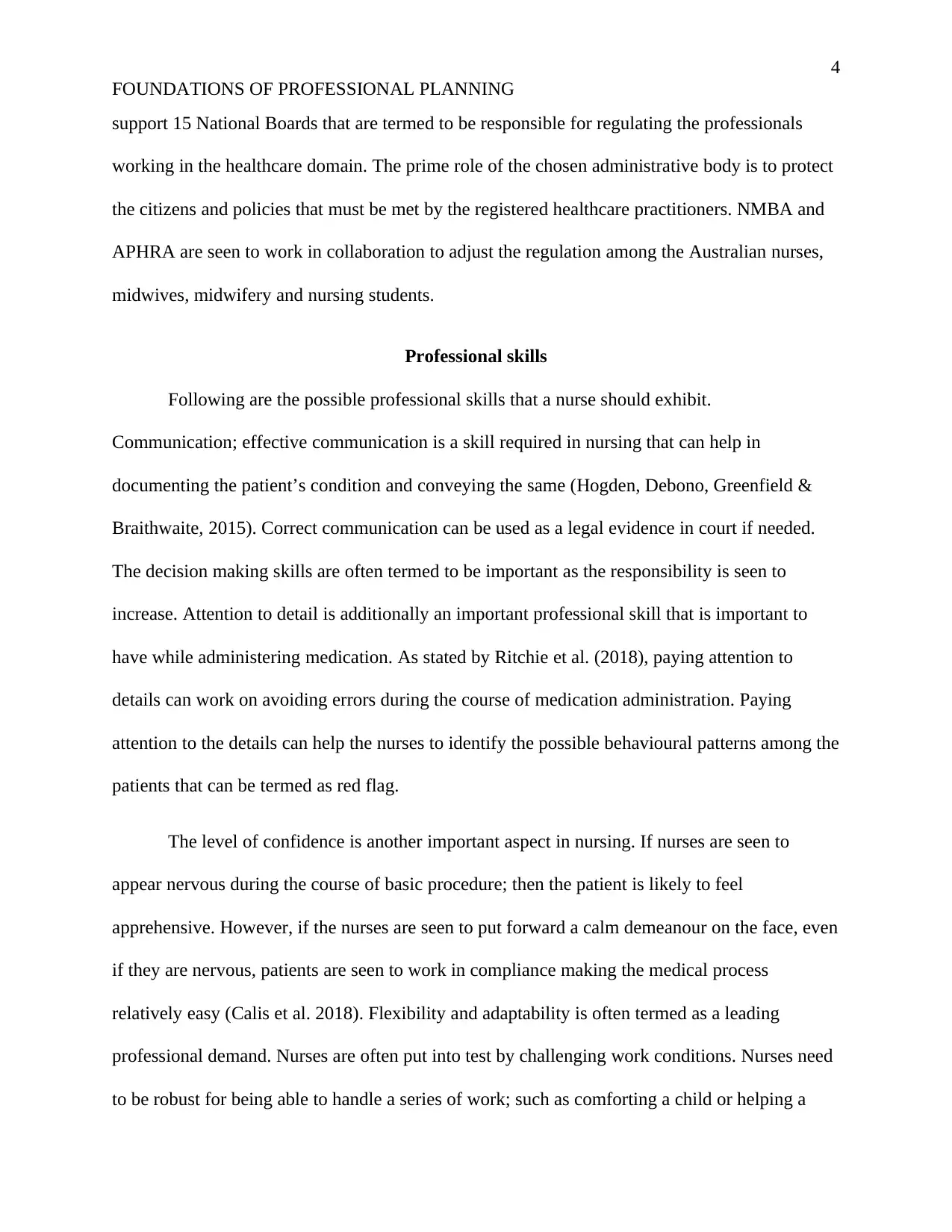
4
FOUNDATIONS OF PROFESSIONAL PLANNING
support 15 National Boards that are termed to be responsible for regulating the professionals
working in the healthcare domain. The prime role of the chosen administrative body is to protect
the citizens and policies that must be met by the registered healthcare practitioners. NMBA and
APHRA are seen to work in collaboration to adjust the regulation among the Australian nurses,
midwives, midwifery and nursing students.
Professional skills
Following are the possible professional skills that a nurse should exhibit.
Communication; effective communication is a skill required in nursing that can help in
documenting the patient’s condition and conveying the same (Hogden, Debono, Greenfield &
Braithwaite, 2015). Correct communication can be used as a legal evidence in court if needed.
The decision making skills are often termed to be important as the responsibility is seen to
increase. Attention to detail is additionally an important professional skill that is important to
have while administering medication. As stated by Ritchie et al. (2018), paying attention to
details can work on avoiding errors during the course of medication administration. Paying
attention to the details can help the nurses to identify the possible behavioural patterns among the
patients that can be termed as red flag.
The level of confidence is another important aspect in nursing. If nurses are seen to
appear nervous during the course of basic procedure; then the patient is likely to feel
apprehensive. However, if the nurses are seen to put forward a calm demeanour on the face, even
if they are nervous, patients are seen to work in compliance making the medical process
relatively easy (Calis et al. 2018). Flexibility and adaptability is often termed as a leading
professional demand. Nurses are often put into test by challenging work conditions. Nurses need
to be robust for being able to handle a series of work; such as comforting a child or helping a
FOUNDATIONS OF PROFESSIONAL PLANNING
support 15 National Boards that are termed to be responsible for regulating the professionals
working in the healthcare domain. The prime role of the chosen administrative body is to protect
the citizens and policies that must be met by the registered healthcare practitioners. NMBA and
APHRA are seen to work in collaboration to adjust the regulation among the Australian nurses,
midwives, midwifery and nursing students.
Professional skills
Following are the possible professional skills that a nurse should exhibit.
Communication; effective communication is a skill required in nursing that can help in
documenting the patient’s condition and conveying the same (Hogden, Debono, Greenfield &
Braithwaite, 2015). Correct communication can be used as a legal evidence in court if needed.
The decision making skills are often termed to be important as the responsibility is seen to
increase. Attention to detail is additionally an important professional skill that is important to
have while administering medication. As stated by Ritchie et al. (2018), paying attention to
details can work on avoiding errors during the course of medication administration. Paying
attention to the details can help the nurses to identify the possible behavioural patterns among the
patients that can be termed as red flag.
The level of confidence is another important aspect in nursing. If nurses are seen to
appear nervous during the course of basic procedure; then the patient is likely to feel
apprehensive. However, if the nurses are seen to put forward a calm demeanour on the face, even
if they are nervous, patients are seen to work in compliance making the medical process
relatively easy (Calis et al. 2018). Flexibility and adaptability is often termed as a leading
professional demand. Nurses are often put into test by challenging work conditions. Nurses need
to be robust for being able to handle a series of work; such as comforting a child or helping a
Paraphrase This Document
Need a fresh take? Get an instant paraphrase of this document with our AI Paraphraser
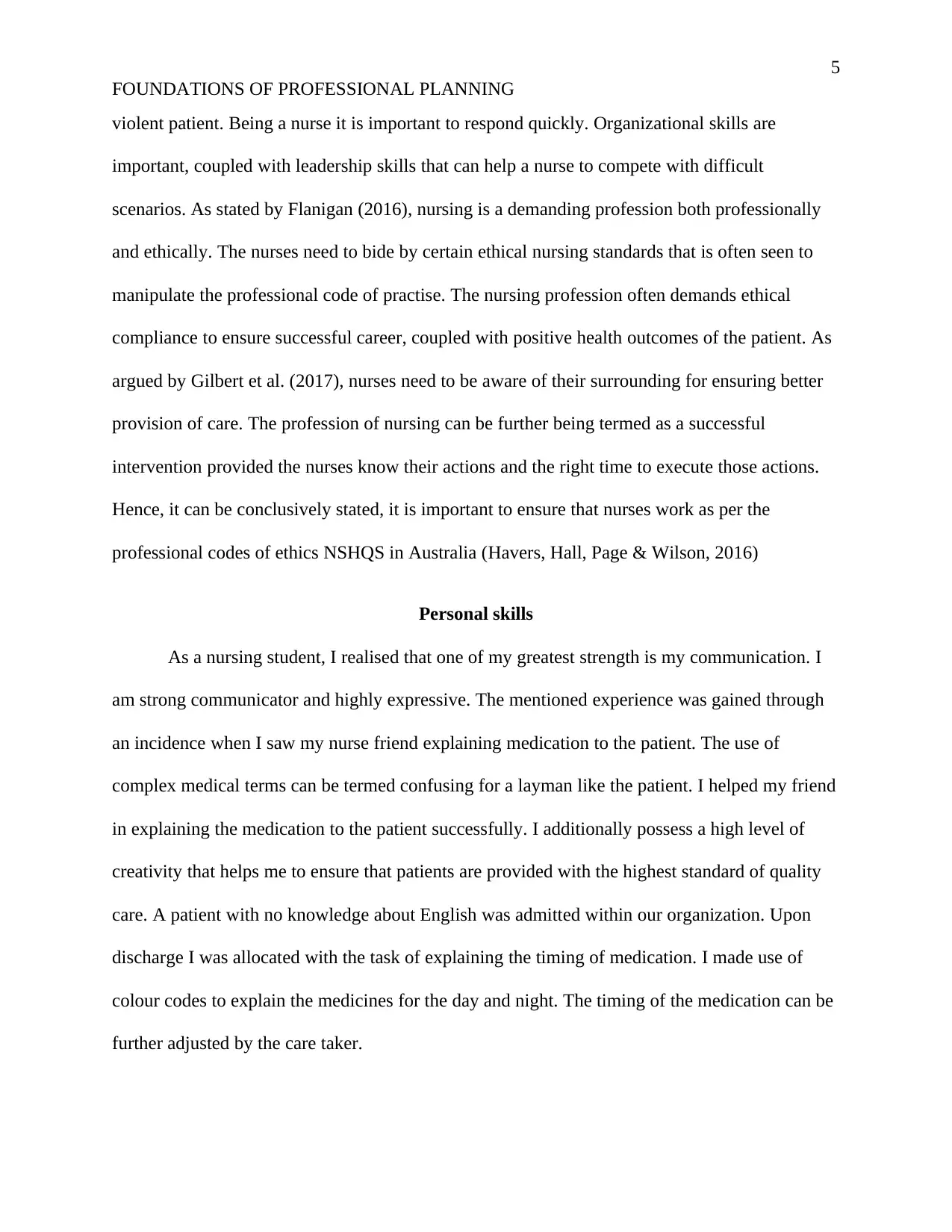
5
FOUNDATIONS OF PROFESSIONAL PLANNING
violent patient. Being a nurse it is important to respond quickly. Organizational skills are
important, coupled with leadership skills that can help a nurse to compete with difficult
scenarios. As stated by Flanigan (2016), nursing is a demanding profession both professionally
and ethically. The nurses need to bide by certain ethical nursing standards that is often seen to
manipulate the professional code of practise. The nursing profession often demands ethical
compliance to ensure successful career, coupled with positive health outcomes of the patient. As
argued by Gilbert et al. (2017), nurses need to be aware of their surrounding for ensuring better
provision of care. The profession of nursing can be further being termed as a successful
intervention provided the nurses know their actions and the right time to execute those actions.
Hence, it can be conclusively stated, it is important to ensure that nurses work as per the
professional codes of ethics NSHQS in Australia (Havers, Hall, Page & Wilson, 2016)
Personal skills
As a nursing student, I realised that one of my greatest strength is my communication. I
am strong communicator and highly expressive. The mentioned experience was gained through
an incidence when I saw my nurse friend explaining medication to the patient. The use of
complex medical terms can be termed confusing for a layman like the patient. I helped my friend
in explaining the medication to the patient successfully. I additionally possess a high level of
creativity that helps me to ensure that patients are provided with the highest standard of quality
care. A patient with no knowledge about English was admitted within our organization. Upon
discharge I was allocated with the task of explaining the timing of medication. I made use of
colour codes to explain the medicines for the day and night. The timing of the medication can be
further adjusted by the care taker.
FOUNDATIONS OF PROFESSIONAL PLANNING
violent patient. Being a nurse it is important to respond quickly. Organizational skills are
important, coupled with leadership skills that can help a nurse to compete with difficult
scenarios. As stated by Flanigan (2016), nursing is a demanding profession both professionally
and ethically. The nurses need to bide by certain ethical nursing standards that is often seen to
manipulate the professional code of practise. The nursing profession often demands ethical
compliance to ensure successful career, coupled with positive health outcomes of the patient. As
argued by Gilbert et al. (2017), nurses need to be aware of their surrounding for ensuring better
provision of care. The profession of nursing can be further being termed as a successful
intervention provided the nurses know their actions and the right time to execute those actions.
Hence, it can be conclusively stated, it is important to ensure that nurses work as per the
professional codes of ethics NSHQS in Australia (Havers, Hall, Page & Wilson, 2016)
Personal skills
As a nursing student, I realised that one of my greatest strength is my communication. I
am strong communicator and highly expressive. The mentioned experience was gained through
an incidence when I saw my nurse friend explaining medication to the patient. The use of
complex medical terms can be termed confusing for a layman like the patient. I helped my friend
in explaining the medication to the patient successfully. I additionally possess a high level of
creativity that helps me to ensure that patients are provided with the highest standard of quality
care. A patient with no knowledge about English was admitted within our organization. Upon
discharge I was allocated with the task of explaining the timing of medication. I made use of
colour codes to explain the medicines for the day and night. The timing of the medication can be
further adjusted by the care taker.
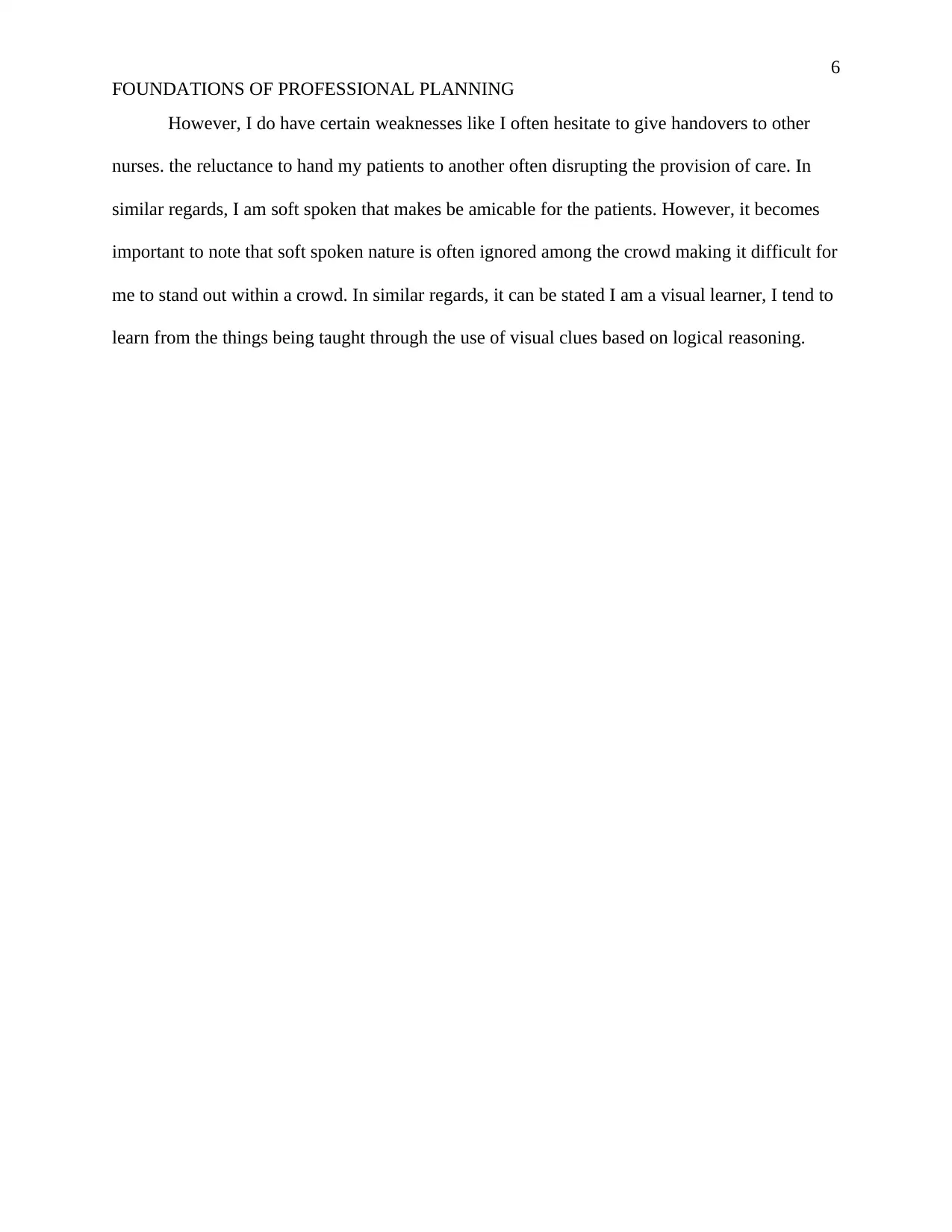
6
FOUNDATIONS OF PROFESSIONAL PLANNING
However, I do have certain weaknesses like I often hesitate to give handovers to other
nurses. the reluctance to hand my patients to another often disrupting the provision of care. In
similar regards, I am soft spoken that makes be amicable for the patients. However, it becomes
important to note that soft spoken nature is often ignored among the crowd making it difficult for
me to stand out within a crowd. In similar regards, it can be stated I am a visual learner, I tend to
learn from the things being taught through the use of visual clues based on logical reasoning.
FOUNDATIONS OF PROFESSIONAL PLANNING
However, I do have certain weaknesses like I often hesitate to give handovers to other
nurses. the reluctance to hand my patients to another often disrupting the provision of care. In
similar regards, I am soft spoken that makes be amicable for the patients. However, it becomes
important to note that soft spoken nature is often ignored among the crowd making it difficult for
me to stand out within a crowd. In similar regards, it can be stated I am a visual learner, I tend to
learn from the things being taught through the use of visual clues based on logical reasoning.
⊘ This is a preview!⊘
Do you want full access?
Subscribe today to unlock all pages.

Trusted by 1+ million students worldwide
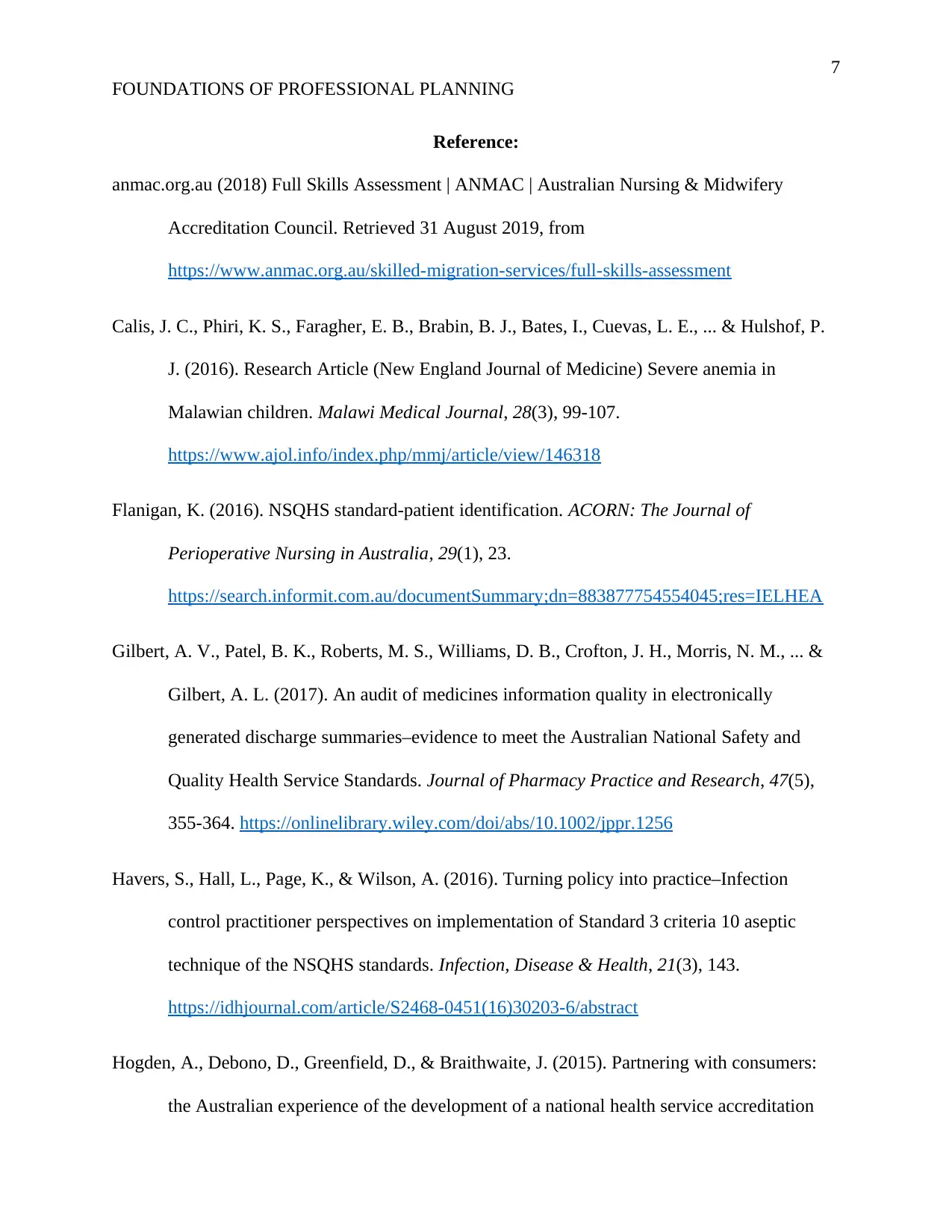
7
FOUNDATIONS OF PROFESSIONAL PLANNING
Reference:
anmac.org.au (2018) Full Skills Assessment | ANMAC | Australian Nursing & Midwifery
Accreditation Council. Retrieved 31 August 2019, from
https://www.anmac.org.au/skilled-migration-services/full-skills-assessment
Calis, J. C., Phiri, K. S., Faragher, E. B., Brabin, B. J., Bates, I., Cuevas, L. E., ... & Hulshof, P.
J. (2016). Research Article (New England Journal of Medicine) Severe anemia in
Malawian children. Malawi Medical Journal, 28(3), 99-107.
https://www.ajol.info/index.php/mmj/article/view/146318
Flanigan, K. (2016). NSQHS standard-patient identification. ACORN: The Journal of
Perioperative Nursing in Australia, 29(1), 23.
https://search.informit.com.au/documentSummary;dn=883877754554045;res=IELHEA
Gilbert, A. V., Patel, B. K., Roberts, M. S., Williams, D. B., Crofton, J. H., Morris, N. M., ... &
Gilbert, A. L. (2017). An audit of medicines information quality in electronically
generated discharge summaries–evidence to meet the Australian National Safety and
Quality Health Service Standards. Journal of Pharmacy Practice and Research, 47(5),
355-364. https://onlinelibrary.wiley.com/doi/abs/10.1002/jppr.1256
Havers, S., Hall, L., Page, K., & Wilson, A. (2016). Turning policy into practice–Infection
control practitioner perspectives on implementation of Standard 3 criteria 10 aseptic
technique of the NSQHS standards. Infection, Disease & Health, 21(3), 143.
https://idhjournal.com/article/S2468-0451(16)30203-6/abstract
Hogden, A., Debono, D., Greenfield, D., & Braithwaite, J. (2015). Partnering with consumers:
the Australian experience of the development of a national health service accreditation
FOUNDATIONS OF PROFESSIONAL PLANNING
Reference:
anmac.org.au (2018) Full Skills Assessment | ANMAC | Australian Nursing & Midwifery
Accreditation Council. Retrieved 31 August 2019, from
https://www.anmac.org.au/skilled-migration-services/full-skills-assessment
Calis, J. C., Phiri, K. S., Faragher, E. B., Brabin, B. J., Bates, I., Cuevas, L. E., ... & Hulshof, P.
J. (2016). Research Article (New England Journal of Medicine) Severe anemia in
Malawian children. Malawi Medical Journal, 28(3), 99-107.
https://www.ajol.info/index.php/mmj/article/view/146318
Flanigan, K. (2016). NSQHS standard-patient identification. ACORN: The Journal of
Perioperative Nursing in Australia, 29(1), 23.
https://search.informit.com.au/documentSummary;dn=883877754554045;res=IELHEA
Gilbert, A. V., Patel, B. K., Roberts, M. S., Williams, D. B., Crofton, J. H., Morris, N. M., ... &
Gilbert, A. L. (2017). An audit of medicines information quality in electronically
generated discharge summaries–evidence to meet the Australian National Safety and
Quality Health Service Standards. Journal of Pharmacy Practice and Research, 47(5),
355-364. https://onlinelibrary.wiley.com/doi/abs/10.1002/jppr.1256
Havers, S., Hall, L., Page, K., & Wilson, A. (2016). Turning policy into practice–Infection
control practitioner perspectives on implementation of Standard 3 criteria 10 aseptic
technique of the NSQHS standards. Infection, Disease & Health, 21(3), 143.
https://idhjournal.com/article/S2468-0451(16)30203-6/abstract
Hogden, A., Debono, D., Greenfield, D., & Braithwaite, J. (2015). Partnering with consumers:
the Australian experience of the development of a national health service accreditation
Paraphrase This Document
Need a fresh take? Get an instant paraphrase of this document with our AI Paraphraser
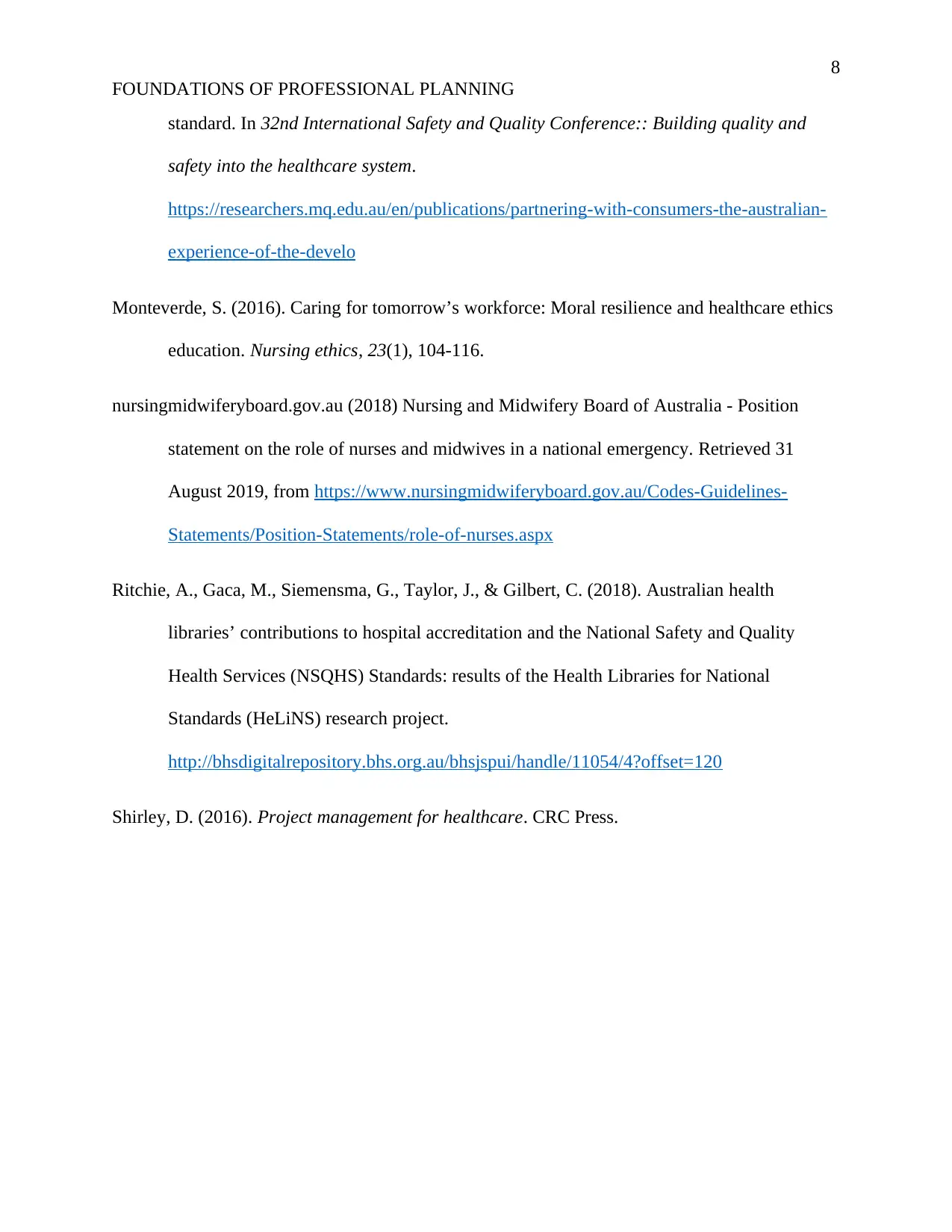
8
FOUNDATIONS OF PROFESSIONAL PLANNING
standard. In 32nd International Safety and Quality Conference:: Building quality and
safety into the healthcare system.
https://researchers.mq.edu.au/en/publications/partnering-with-consumers-the-australian-
experience-of-the-develo
Monteverde, S. (2016). Caring for tomorrow’s workforce: Moral resilience and healthcare ethics
education. Nursing ethics, 23(1), 104-116.
nursingmidwiferyboard.gov.au (2018) Nursing and Midwifery Board of Australia - Position
statement on the role of nurses and midwives in a national emergency. Retrieved 31
August 2019, from https://www.nursingmidwiferyboard.gov.au/Codes-Guidelines-
Statements/Position-Statements/role-of-nurses.aspx
Ritchie, A., Gaca, M., Siemensma, G., Taylor, J., & Gilbert, C. (2018). Australian health
libraries’ contributions to hospital accreditation and the National Safety and Quality
Health Services (NSQHS) Standards: results of the Health Libraries for National
Standards (HeLiNS) research project.
http://bhsdigitalrepository.bhs.org.au/bhsjspui/handle/11054/4?offset=120
Shirley, D. (2016). Project management for healthcare. CRC Press.
FOUNDATIONS OF PROFESSIONAL PLANNING
standard. In 32nd International Safety and Quality Conference:: Building quality and
safety into the healthcare system.
https://researchers.mq.edu.au/en/publications/partnering-with-consumers-the-australian-
experience-of-the-develo
Monteverde, S. (2016). Caring for tomorrow’s workforce: Moral resilience and healthcare ethics
education. Nursing ethics, 23(1), 104-116.
nursingmidwiferyboard.gov.au (2018) Nursing and Midwifery Board of Australia - Position
statement on the role of nurses and midwives in a national emergency. Retrieved 31
August 2019, from https://www.nursingmidwiferyboard.gov.au/Codes-Guidelines-
Statements/Position-Statements/role-of-nurses.aspx
Ritchie, A., Gaca, M., Siemensma, G., Taylor, J., & Gilbert, C. (2018). Australian health
libraries’ contributions to hospital accreditation and the National Safety and Quality
Health Services (NSQHS) Standards: results of the Health Libraries for National
Standards (HeLiNS) research project.
http://bhsdigitalrepository.bhs.org.au/bhsjspui/handle/11054/4?offset=120
Shirley, D. (2016). Project management for healthcare. CRC Press.
1 out of 8
Related Documents
Your All-in-One AI-Powered Toolkit for Academic Success.
+13062052269
info@desklib.com
Available 24*7 on WhatsApp / Email
![[object Object]](/_next/static/media/star-bottom.7253800d.svg)
Unlock your academic potential
Copyright © 2020–2025 A2Z Services. All Rights Reserved. Developed and managed by ZUCOL.





